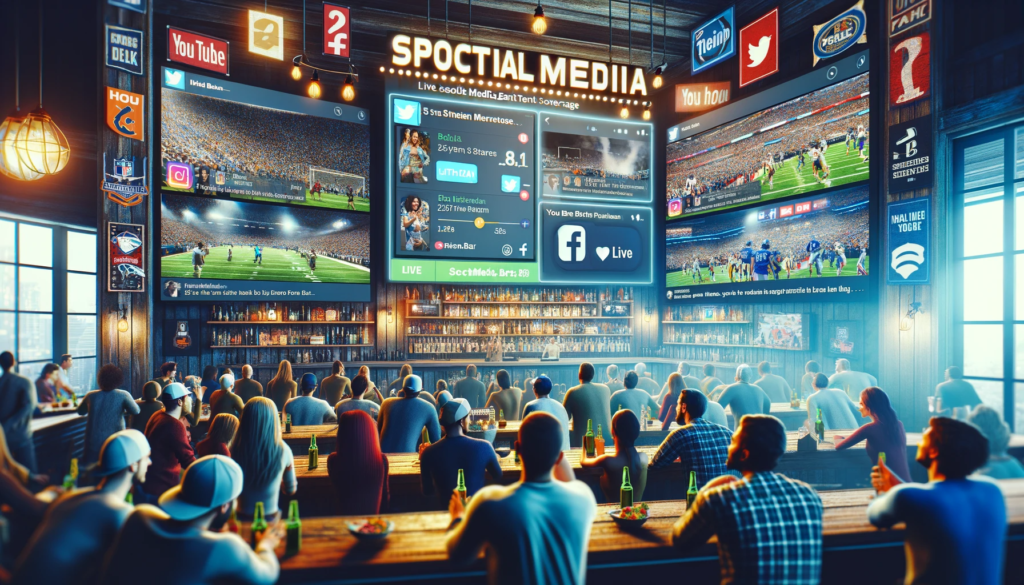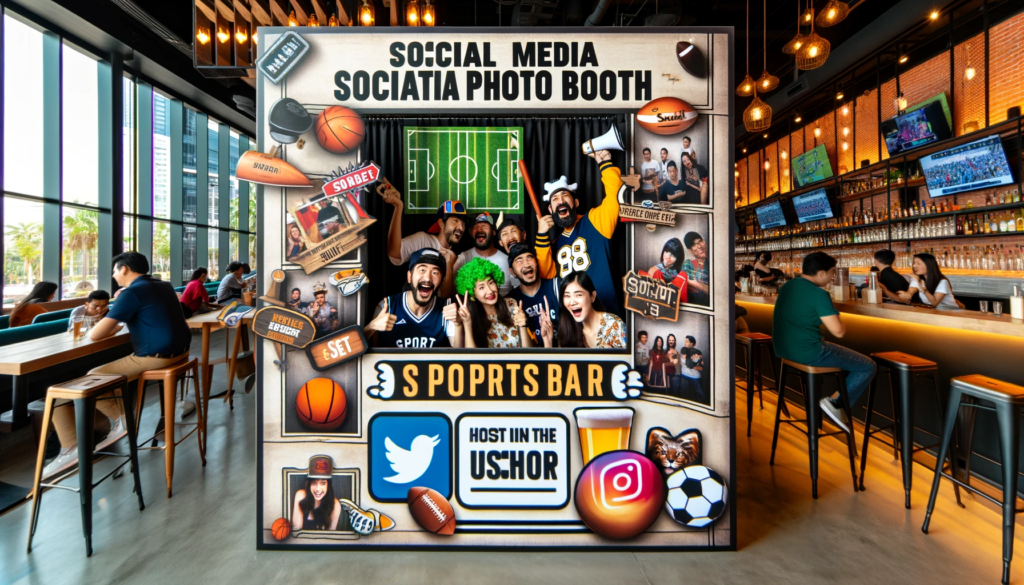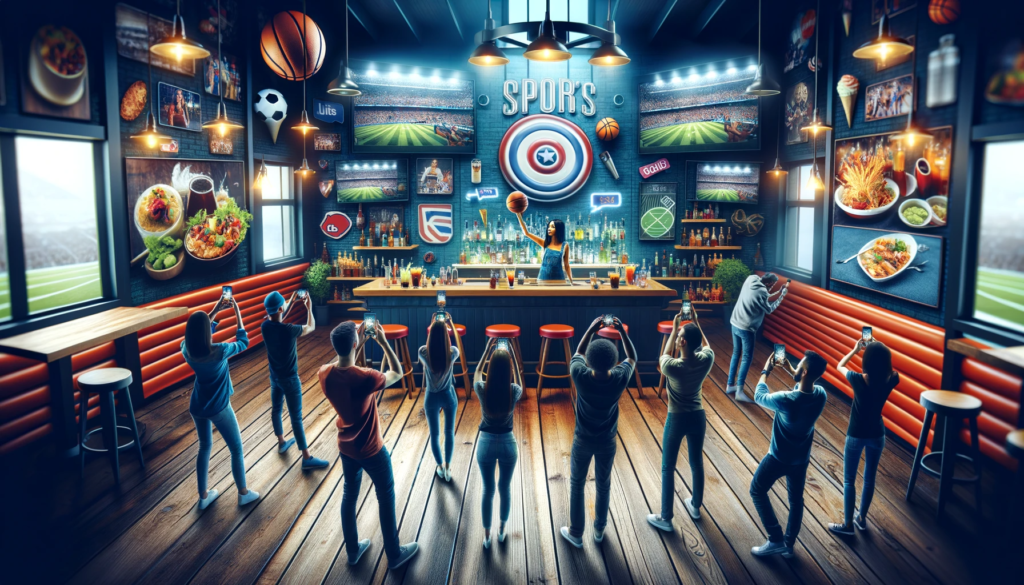Social media advertising has become an incredibly powerful tool for sports bars in reaching and engaging potential customers. With the widespread use of social platforms, it presents a unique opportunity to connect with sports enthusiasts and promote their offerings. This article aims to explore strategies and techniques for sports bars to maximize their return on investment (ROI) from social media advertising campaigns.
In today's digital age, social media has become an integral part of people's lives. Millions of users log onto social platforms every day to connect with friends, share content, and stay updated on the latest news and trends. For sports bars, this presents a golden opportunity to target their ideal audience and drive engagement. By leveraging social media advertising, sports bars can effectively reach sports enthusiasts who are most likely to be interested in their offerings.
For example, let's consider a sports bar located in Manchester, UK, that wants to promote its special live screening of a Manchester United football match. By utilising social media advertising, the sports bar can create targeted campaigns that specifically reach Manchester United fans in the area. They can tailor their ad content with enticing offers, such as discounted drinks during the match, to attract the attention of football fans. This targeted approach ensures that the sports bar is reaching the right audience, maximizing the chances of engagement and conversion.

Significance of Social Media Advertising ROI for Sports Bars
Measuring ROI is vital for sports bars as it allows them to evaluate the effectiveness of their social media advertising campaigns. By determining the ROI, sports bars can make informed decisions about resource allocation and campaign optimization. ROI calculation takes into account the costs associated with social media advertising, including time, content creation, tools, and ad expenditure. Understanding ROI helps sports bars ensure efficiency and accountability in their marketing efforts.
For instance, let's say a sports bar invests £500 in a social media advertising campaign to promote their weekend live music events. Through careful tracking of conversions and revenue generated from the campaign, they find that they earned £1000 in revenue. By calculating the ROI using the formula (Revenue - Cost of Investment / Cost of Investment) x 100, they discover that their ROI for this campaign is 100%. This means that for every pound they spent on advertising, they earned an additional pound in revenue. This insight enables the sports bar to gauge the profitability of their marketing efforts and make data-driven decisions for future campaigns.
To calculate ROI, sports bars need to track key metrics such as conversions, website traffic, and revenue generated from their social media advertising campaigns. By measuring these metrics, sports bars can assess the profitability of their campaigns and make data-driven decisions for future strategies. For example, if a sports bar invests a significant amount of money in a social media advertising campaign but sees minimal conversions and revenue, they can adjust their approach by targeting a different audience or refining their ad content to improve results.
By regularly measuring ROI, sports bars can gain insights into the effectiveness of their social media advertising efforts and optimize their campaigns accordingly. This not only helps them allocate their resources wisely but also ensures that they are getting the most out of their advertising budget. Ultimately, maximizing ROI in social media advertising allows sports bars to achieve their business objectives and drive long-term success.
Setting Social Media Advertising Goals for Sports Bars
Setting clear goals is essential for sports bars to maximize their ROI from social media advertising campaigns. Defining the purpose of social media for sports bars helps in determining specific goals. It is crucial to establish goals that are measurable and aligned with the overall business objectives.
Sports bars can set measurable goals such as increasing email sign-ups, inquiries, trials, purchases, and downloads. These goals provide tangible metrics that can be tracked and analyzed to assess the success of social media advertising campaigns. For example, a sports bar may aim to increase the number of email sign-ups by 20% within three months through their social media advertising efforts.
By setting achievable goals, sports bars can track the success of their campaigns and adjust strategies accordingly. They can monitor the performance of their ads, track the engagement metrics, and analyze the conversion rates to determine if they are on track to achieve their goals. If the initial goals are not being met, sports bars can adapt their strategies, refine their targeting, or optimize their ad content to improve results.

Targeting Strategies for Social Media Advertising in Sports Bars
Sports bars need to target their audience effectively to maximize ROI. Generic advertising that reaches a wide range of people may lead to low engagement and conversion rates. To ensure that their social media advertising campaigns are successful, sports bars should utilize targeting options available on social media platforms.
For example, let's consider a sports bar in London that wants to attract local customers to their weekly pub quiz events. By using the targeting options on social media platforms, they can narrow down their audience to people living in London and who have shown an interest in pub quizzes. They can also further refine their targeting by selecting relevant age groups and specific interests related to pub quizzes and trivia nights. This targeted approach ensures that the sports bar's ads are reaching the right audience, increasing the chances of engagement and conversion.
Tailoring ad content to the preferences of the target audience is also crucial for effective targeting. By understanding the interests and needs of their audience, sports bars can create ad content that resonates with them. For example, a sports bar targeting sports enthusiasts could create ad content that highlights their extensive collection of sports memorabilia and the unique atmosphere they provide during live sporting events.
Ad Optimization Techniques for Better Performance
Optimizing ads is key to enhancing their performance and increasing the chances of achieving higher ROI. Creating visually appealing and compelling ad content is essential to capture the attention of the target audience. High-quality images or videos showcasing the sports bar's atmosphere, food, and drinks can significantly improve engagement rates.
Conducting A/B testing is another effective technique for optimizing ads. By creating multiple variations of an ad and testing them against each other, sports bars can identify the most effective ad content and targeting strategies. For example, a sports bar could test two different ad headlines or images to see which one generates higher click-through rates or conversions. This data-driven approach helps sports bars refine their ad content and targeting to maximize ROI.
Optimizing ad performance involves refining targeting strategies, adjusting ad formats, and improving call-to-action elements. Sports bars can continually analyze the performance of their ads, monitor the engagement metrics, and make data-driven adjustments. For instance, if a sports bar notices that their ad targeting is not reaching the desired audience, they can refine their audience parameters or explore different targeting options to improve results.
Measuring ROI in Social Media Advertising for Sports Bars
Measuring ROI is essential to determine the effectiveness of social media advertising for sports bars. Key metrics for measuring ROI include conversions, website traffic, and revenue generated. By tracking these metrics, sports bars can assess the profitability of their social media advertising efforts and make data-driven decisions for future campaigns.
Tools like Google Analytics provide valuable data to track and analyze these metrics. Sports bars can set up conversion tracking, monitor website traffic generated from social media platforms, and attribute revenue to specific social media campaigns. This data allows sports bars to compare their campaign costs with the achieved results, enabling them to calculate the ROI accurately.
For example, a sports bar can use Google Analytics to track the number of conversions (such as online reservations or event ticket purchases) that can be attributed to their social media advertising efforts. They can then compare the revenue generated from these conversions to the cost of their social media advertising campaign. By calculating the ROI using the formula mentioned earlier, the sports bar can determine the profitability and success of their social media advertising efforts.
Calculating ROI ensures sports bars can assess the profitability of their social media advertising efforts. It helps them make data-driven decisions and allocate their resources effectively. By regularly measuring ROI, sports bars can identify areas of improvement, optimize their campaigns, and maximize their return on investment.

Successful Social Media Advertising Campaigns for Sports Bars
Real-life examples of successful social media advertising campaigns can provide valuable insights for sports bars aiming to maximize their ROI. Let's explore a case study of a sports bar in Manchester that implemented an effective social media advertising campaign.
The sports bar identified their target audience as football fans who enjoy watching matches in a lively atmosphere. They created a series of engaging video ads showcasing the sports bar's big screens, energetic crowd, and exclusive matchday offers. The ads were specifically targeted towards Manchester United and Manchester City football fans in the area.
To measure the success of the campaign, the sports bar tracked key metrics such as the number of reservations made, the increase in revenue during match days, and the growth in social media followers. They found that the campaign resulted in a 30% increase in reservations and a 20% boost in revenue during match days. Additionally, they experienced a significant growth in their social media following, indicating a higher brand awareness and engagement.
This case study highlights the impact of targeted campaigns, engaging content, and strategic ad placement. By understanding their audience and tailoring their ads to their preferences, sports bars can achieve high engagement rates and drive conversions through social media advertising.
Costs Involved in Social Media Advertising for Sports Bars
Sports bars should consider various costs associated with social media advertising to maximize their ROI. These costs include time invested in managing social media accounts, creating content, and monitoring campaigns. Additionally, sports bars may incur expenses related to social media tools and ad expenditure.
For example, a sports bar may need to allocate resources to hire a social media manager or content creator to handle their social media advertising campaigns. They may also need to invest in paid advertising on social media platforms to reach a wider audience. Additionally, tools like social media management platforms or analytics software may require subscription fees.
Understanding the costs involved helps in budgeting and optimizing resource allocation. By carefully considering the costs, sports bars can ensure that their social media advertising campaigns are cost-effective and generate a positive ROI. They can assess the profitability of their campaigns by comparing the costs incurred with the results achieved, enabling them to make informed decisions about their advertising strategies.
Tips for Maximizing ROI in Social Media Advertising for Sports Bars
To maximize ROI in social media advertising, sports bars can implement several strategies and techniques. Here are some tips to consider:
- Optimizing posting frequency and timing: By analyzing social media insights and engagement metrics, sports bars can determine the optimal times and frequency to post their content. This ensures maximum visibility and engagement with their target audience.
- Leveraging social data and insights: Sports bars can utilize the data and insights provided by social media platforms to refine their targeting strategies and content. By understanding the preferences and behaviours of their audience, sports bars can tailor their ads to better resonate with their target market.
- Exploring social commerce opportunities: Sports bars can tap into social commerce by incorporating features such as online ordering, ticket sales, or reservations through their social media platforms. This can drive conversions and revenue directly from their social media advertising campaigns.
- Regular monitoring, analysis, and adaptation: Continuous monitoring of social media campaigns is essential for sports bars to identify what works and what doesn't. By analyzing the performance metrics and making data-driven adjustments, sports bars can optimize their campaigns for better ROI.
For example, a sports bar can use social media analytics to identify the most engaging type of content and adjust their content strategy accordingly. They can also experiment with different ad formats, such as carousel ads or video ads, to see which ones generate higher engagement and conversion rates.
Tools for Tracking and Managing Social Media Campaigns
To track and manage social media campaigns effectively, sports bars can utilize various tools available in the market. Here are two popular tools that can assist sports bars in optimizing their social media advertising efforts and achieving higher ROI:
- Google Analytics: Google Analytics provides in-depth data on website traffic, conversions, and user behavior. Sports bars can set up conversion tracking to measure the impact of their social media advertising campaigns on website conversions. This tool allows them to track the effectiveness of their campaigns, analyze the performance metrics, and make data-driven decisions for better ROI.
- Sprout Social: Sprout Social offers a comprehensive suite of features for scheduling posts, monitoring engagement, and measuring campaign performance. It provides sports bars with valuable insights into their social media campaigns, allowing them to track engagement metrics, monitor mentions, and analyze the performance of their content. This data helps sports bars optimize their social media advertising efforts and achieve higher ROI.
By leveraging these tools, sports bars can gain valuable insights into the performance of their social media advertising campaigns. They can track key metrics, analyze the data, and make informed decisions to optimize their campaigns for better ROI.

Conclusion
Social media advertising offers tremendous opportunities for sports bars to reach and engage with their target audience. By implementing effective strategies and techniques, sports bars can maximize their return on investment (ROI) from social media advertising campaigns.
Measuring ROI is crucial for sports bars to evaluate the effectiveness of their social media advertising efforts. It allows them to make informed decisions about resource allocation and campaign optimization. By setting specific goals, targeting their audience effectively, optimizing their ads, and measuring key metrics, sports bars can enhance their ROI and drive long-term success.
To achieve the best results, sports bars should continuously monitor, analyze, and adapt their social media advertising campaigns. By staying up to date with the latest trends and tools, sports bars can stay ahead of the competition and maximize their ROI in social media advertising. With careful planning and execution, social media advertising can be a powerful tool for sports bars to attract customers and grow their business.